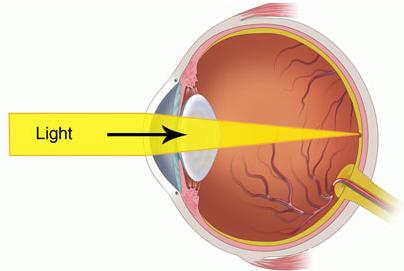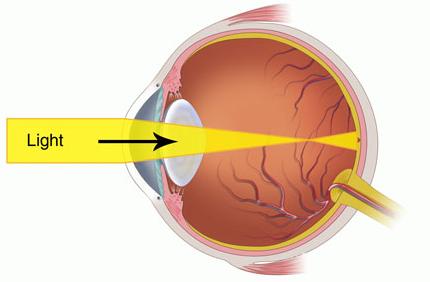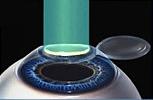Clear vision is the result of light rays passing through the cornea, pupil and lens and focusing directly upon the retina. Sometimes light rays focus either in front of or behind the retina. This results in ‘refractive errors’ such as near-sightedness (myopia), far-sightedness (hyperopia), astigmatism. These conditions cause blurred vision.
| Normal (Emmetropia) • Light Rays Focus on the Retina • Vision is Clear |
 |
| Myopia (Shortsightness) • Light Rays Focus in Front of the Retina • Vision is Blurred |
 |
| Hyperopia (Farsightness) • Light Rays Focus at the back of the Retina • Vision is Blurred |
 |
Ray Diagram of the Eye for Normal Eyes(Emmetropia), Near Sightedness (Myopia) and Farsightedness (Hyperopia)
Laser refractive surgery refers to the various surgical procedures, which can be used to correct these vision problems. Laser refractive surgery works by altering the shape of the cornea so that light rays can be focused directly on the retina, and in many cases the patient’s need for glasses or contact lenses is eliminated or dramatically reduced.
There are many types of laser refractive surgery and includes LASIK and PRK. LASIK is the most popular type of laser refractive surgery. The latest technique of laser refractive surgery is ReLEx®SMILE.
Lasik
LASIK (laser-assisted in situ keratomileusis) is a reliable and painless way to improve vision and reduce or eliminate the need to wear glasses or contact lenses. LASIK changes the way light is bent, or refracted, as it passes through the cornea so that it focuses properly on the retina and objects can be seen clearly. LASIK has been approved by the Food and Drug Administration for a wide range of near sightedness, farsightedness, and astigmatism.
During LASIK, a corneal flap is created. This can be done by either using a device called a microkeratome which cuts a thin flap on the surface of the cornea or using laser to create the flap without a blade. Patients are given topical anaesthesia so they do not feel pain. Next, the flap is lifted and laser is used to reshape the corneal curvature to improve vision. The flap is then replaced and allowed to seal without stitches
 |
A Corneal Flap is Created and Lifted |
 |
Reshaping the Cornea with Laser |
 |
The Corneal Flap is Repositioned |
Diagrammatic Description of LASIK
Patient will be allowed to go home on the same day of surgery but will need to return for follow up appointments at scheduled intervals thereafter. Eye drops will be prescribed for a few days, along with post-operative instructions. Full recovery takes a few weeks.
Indications
- Far sightedness
- Near sightedness
- Astigmatism
Contraindications
- Unstable refraction
- Thin cornea
- Certain diseases of the cornea
- Systemic collagen vascular disease
- Immunodeficiency
- Autoimmune disease
- Severe atopy
- Diabetes mellitus
- Severe dry eyes
- Uncontrolled blepharitis
- Uveitis
- Early cataract
- Pregnant patients
The doctor will examine the eye to see if it is suitable for laser refractive surgery based on the amount of refractive error, examination findings and any existing ocular or medical contraindications
Preoperative Evaluation
Preoperative evaluation will include:
- A full medical and ophthalmic history
- A complete eye examination
- Measurement of topography
- Measurement of corneal thickness
- Measuring of pupil size and eye movements
- Refraction
- Evaluation of tear film and ocular surface
Rigid contact lens should be removed for several weeks before examinations and soft contact lens for several days to weeks before examinations. Refraction should be stable before LASIK surgery.
Prior to the procedure informed consent will be obtained from the patient.
Lasik Side Effects and Complications
The following are some of the possible side effects and complications
- Under correction or over correction
- Dry eyes
- Night time starbursts
- Reduced contrast sensitivity
- LASIK flap related complication such as free flap, incomplete, buttonholed, or slip/displaced flap
- Diffuse lamellar keratitis
- Infection
- Epithelial ingrowth
Serious adverse complications leading to significant permanent visual loss are rare but potential may happen.
Post Operative Care
Patients may have postoperative discomfort on the day of surgery. Patients should not rub their eyes after surgery
- Steroids and antibiotic eye drops are prescribed after surgery
- Preservative free artificial tears may be prescribed to be used for weeks to months depending on the presence of dry eye symptoms and corneal punctate staining
- Refractive stabilization for myopes may take up to 3 months depending on the amount of treatment performed
- Residual refractive error can be corrected after stabilization (enhancement)
Outcomes of Lasik
Low to moderate myopia has a better predictability of outcome compared to high myopia. For higher degrees of myopia and astigmatism, the results may be more variable.
ReLEx®SMILE LASER REFRACTIVE SURGERY
ReLEx® (Refractive Lenticule Extraction) SMILE (Small Incision Lenticule Extraction) is the latest laser eye surgery techniques used to treat short-sightness with or without astigmatism.
The treatment is available in only a few laser eye surgery centre.
Patients gets all benefit of LASIK – rapid healing and very little discomfort but without having a corneal flap.
Photorefractive Keratectomy (PRK)
PRK stands for photorefractive keratectomy. It was the original laser refractive surgery procedure first approved by the FDA in 1997.
PRK utilizes the same excimer laser that is used in LASIK surgery. The difference is that instead of reshaping the cornea under a flap, the procedure is performed on the top surface on the cornea. Because of this, the patient is left with an abrasion on the cornea that takes longer to heal than in LASIK surgery. Patients notice a gradual improvement in vision over the first week to ten days following PRK, and it may take several months to achieve final results.
PRK works just as well as LASIK for correcting a variety of refractive errors, but is not as comfortable for the patient. The surgeon will decide the best type of refractive surgery depending on the amount of the refractive error and examination findings.
| Last Reviewed | : | 23 August 2019 |
| Writer | : | Dr. Rosniza bt. Ab. Razak |
| Accreditor | : | Dr. Shamala A/P Retnasabapathy |
| Reviewer | : | Dr. Rosniza bt. Ab. Razak |







